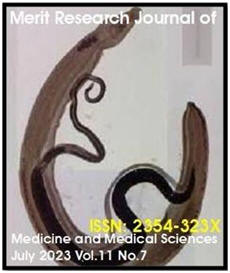
|
|
|
|
|
|
/ / MRJMMS Home / / About MRJMMS / / Submit Manuscripts / / Call For Articles / / Editorial Board / / Archive / / Author's Guide / /
|
Other viewing option
• Full text •Reprint (PDF) (296 KB)
Nkenna
CU
|
Original Research Article Risk of Faecal Contamination of Water used by Food Vendors in Owerri Munipality, Imo State Nigeria |
|||
|
Chigbo Udoka Nkenna |
||||
|
Department of Medical Microbiology,
College of Medicine, Imo State University, Owerri |
||||
|
Abstract |
||||
|
Assessment of
faecal contamination of water is a key factor in assessing the
quality and safety of food. It also reveals the level of hygiene
adopted by food handlers in the course of preparation and
serving of such foods. This study assessed the risk of microbial
contamination of water used by food vendors in Owerri munipality,
Imo State Nigeria between January-December 2019 with an emphasis
on total coliforms and the faecal coliforms/faecal indicator
bacteria (FIB) – Escherichia coli (E. coli) and thermotolerant
coliforms (TTC). One hundred and thirty water samples collected
across three vending types (street vendors, high level and low
level restaurants) were evaluated for microbial contamination
using standard methods. Data obtained was statistically analyzed
with p-value set at 0.05 significance level. The result
identified Enterobacter spp. and Klebsiella spp. The result
showed that 48.46% (63) of the 130 water samples examined were
contaminated with coliform bacteria, of which 20 (22.22%)
samples had faecal coliform bacteria, representing 10.77% of the
entire water samples examined. Of the 64 samples from water used
for food preparation, 12.50% (8) had faecal coliform bacteria as
against 9.09% (6) of 66 samples collected from water offered to
customers for drinking. The result showed that 116 (89.23%) of
the 130 water samples recorded no faecal coliform contami-nation,
hence they were considered excellent based on the guidelines for
determination of faecal contamination of water. Two samples had
faecal coliform counts of 1-3 per 100 ml of water accounting for
1.54% of water samples, which is considered Satisfactory. The
result revealed suspicious (4-9 per 100 ml) coliform count in 9
(6.92%) water samples, while three water samples (2.31%) had ≥10
count and are classified as unsatisfactory. The result revealed
that 89.23% (116) of the examined water samples were of ‘no
risk’ to the public, which was significantly higher than 8.46%
(11) and 2.31% (3) recognized as being of low and intermediate
risk respectively (p <0.05). High and very high risk water
samples were not encountered in the study. This trend in
qualification of risk of water samples reflected in the two
types of water usages, and the observed differences was however
not statistically significant (p>0.05). |
Merit Research Journals© 2023 || Advertisement | Privacy policy.
